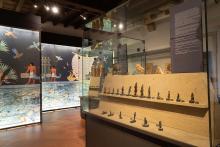Archaeological Museum
The itinerary of the archaeological collection begins with findings from pre-Roman times, coming from necropolises in the area surrounding Padova and dated from the 8th to the 3rd centuries B.C.
Many of the mosaics have been arranged either on the floor or on racks, including the mosaic of Eutherius of the 4th century A.D.
Of note is the very beautiful bust of Silenus, the elegant funerary memorial of the young dancer and juggler Claudia Toreuma, and the monumental funerary aedicula of the Volumnii family. Other smaller rooms house Etruscan, Greek and Italiot materials, and two rooms the Egyptian collections.
The section devoted to the Via Annia, the wide road built in Roman times to link north-eastern Italy with the rest of the road network of the entire Italian peninsula, was opened in 2008. This project involved the restoration and enhancement of the route which ran to Aquileia, further to the east, crossed the territories of Padova Altino and Concordia, and linked up with a city further south. Scholars are still debating whether this location was Adria or Bologna. Thanks to a multimedial station and touch screen, modern Archaeological Museums along this route can be followed and its history can be better known.
Info:
City Museums, Piazza Eremitani 8
tel. +39 049 8204551
fax +39 049 8204585
Open all year: 09:00 am - 7:00 pm
Closed: Mondays (unless public holidays), January 1, May 1, December 25 and 26.
The Scrovegni Chapel is open, even on Mondays.
for tickets click here
To reach Palazzo Zuckermann, City Museums and Scrovegni Chapel:
from train station: buses 3, 10, 12; Sundays and holidays: buses 32, 42.
by car and coach: motorway exit Padova Est, parking at Fiera (Fair): shuttle bus service from Via Tommaseo to centre of city; or motorway exits Padova Sud and Padova Ovest, parking in Prato della Valle, with shuttle bus service to centre of town, Via Valeri (off Via Trieste), Piazza Insurrezione.









